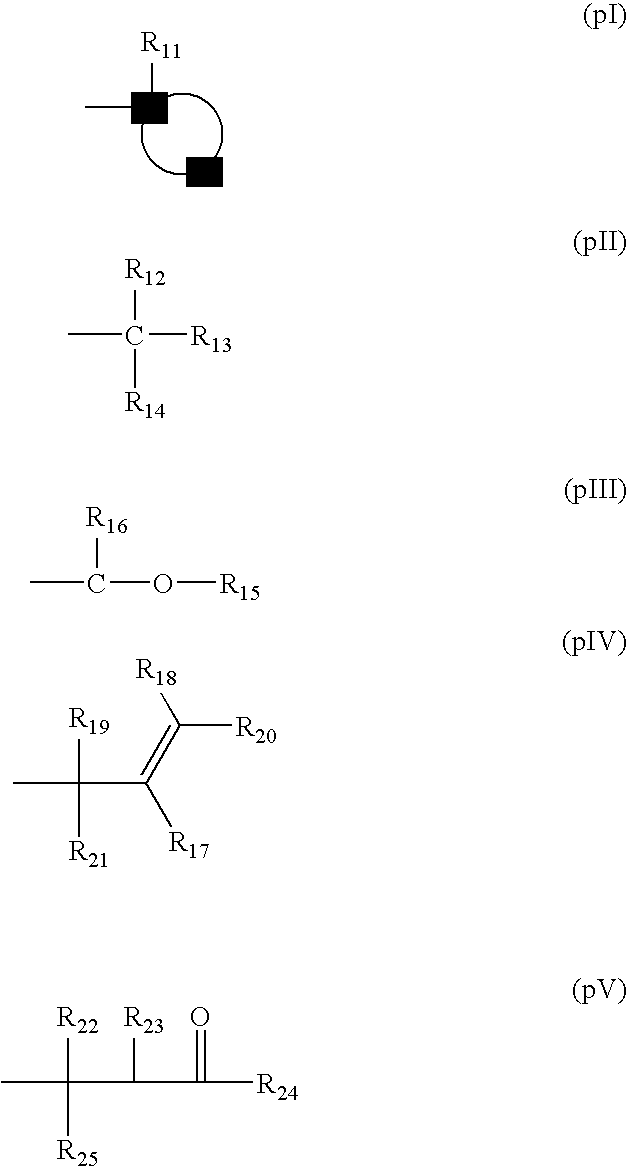Positive resist composition and pattern forming method using the same
a composition and resist technology, applied in the direction of photosensitive materials, instruments, photo-taking processes, etc., can solve the problems of poor solubility of polymers, insufficient resist performance of chemical amplification systems, and difficult to achieve sufficient resist performance only by using protective groups, etc., to achieve the effect of reducing development defects
- Summary
- Abstract
- Description
- Claims
- Application Information
AI Technical Summary
Benefits of technology
Problems solved by technology
Method used
Image
Examples
example 1
[0500]The present invention will hereinafter be described in further detail by using Examples, but the present invention is not limited to or by them.
[0501]The following are monomers corresponding to recurring units used for the synthesis of the resin (A) used in Examples.
[0502]
synthesis examples 1 to 17
of Resin A
[0503]Under a nitrogen gas stream, 4.7 g of cyclohexanone was charged in a three-necked flask and heated to 80° C. Then, a solution obtained by dissolving 4.70 g of (LM-1), 2.52 g of (IM-1), 2.30 g of (PM-1), 2.40 g of (PM-9), 0.0821 g of a polymerization initiator (azobisisobutyronitrile (AIBN): product of Wako Pure Chemical Industries, Ltd.), and 0.947 g of the compound (Si) of the present invention in 41.9 g of cyclohexanone was added dropwise over 6 hours. After completion of the dropwise addition, the resulting mixture was reacted for 2 hours at 80° C. The reaction solution was allowed to cool down and then added dropwise to 700 ml of methanol over 20 minutes. Powders thus precipitated were collected by filtration, followed by drying to yield 7.5 g of the intended resin (A-1). The resin thus obtained had a weight average molecular weight of 7300 in terms of standard polystyrene and dispersity (Mw / Mn) of 1.4.
[0504]In a similar manner, resins (A-2) to (A-17) were synthe...
examples 1-8 , 10-17
Examples 1-8, 10-17 and Comparative Examples 1-2<
Preparation of a Resist Solution
[0511]A positive resist solution was prepared by dissolving the components shown below in Table 2 in a solvent to prepare a solution having a solid concentration of 5% and filtering the resulting solution through a 0.1-μm polyethylene filter. The positive resist solution thus prepared was evaluated in the following manner.
[Standard Resist Evaluation]
[0512]An antireflective film ARC29A (product of Brewers Science, Ltd.) was uniformly applied onto a silicon substrate with a thickness 780 angstroms by using a spin coater and dried on a hot plate at 205° C. for 60 seconds, followed by cooling to room temperature. Each of the positive resist solutions was then applied by using a spin coater and dried at 120° C. for 60 seconds to form a resist film of 160 nm.
[0513]The resulting resist film was exposed through a 90-nm 1 / :1 line-and-space mask by using an ArF excimer laser stepper (product by ASML, NA=0.75) whi...
PUM
| Property | Measurement | Unit |
|---|---|---|
| temperature | aaaaa | aaaaa |
| temperature | aaaaa | aaaaa |
| temperature | aaaaa | aaaaa |
Abstract
Description
Claims
Application Information
 Login to View More
Login to View More - R&D
- Intellectual Property
- Life Sciences
- Materials
- Tech Scout
- Unparalleled Data Quality
- Higher Quality Content
- 60% Fewer Hallucinations
Browse by: Latest US Patents, China's latest patents, Technical Efficacy Thesaurus, Application Domain, Technology Topic, Popular Technical Reports.
© 2025 PatSnap. All rights reserved.Legal|Privacy policy|Modern Slavery Act Transparency Statement|Sitemap|About US| Contact US: help@patsnap.com



